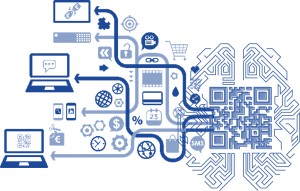Annual online sales are predicted to surpass $500 billion by the end of this decade.[1] Getting a share of that pot of gold requires retailers to focus on their digital path to purchase strategies. Nowadays almost every shopper is armed with a smartphone they use to compare prices, download coupons, or find reviews. Even when the final purchase is made in a traditional brick-and-mortar store, there is a good chance the consumer has tapped the digital realm to help with that decision. James LeTart (@JLeTartcomm), Director of Thought Leadership at JDA Software, puts it this way, “There’s a new boss in town and she is tougher than any boss you’ve had before. She wants what she wants, when and where she wants it. She’s the new digitally-empowered consumer and she is dictating how retailers and consumer goods companies must transform their supply chains to serve her.”[2]
Brenna Keough (@brennakeough), an Interactive Marketing Specialist at ZAG Interactive, observes, “Marketing has changed quite a bit over the past several years — and that’s a good thing. We’ve gone from mass messaging to strategically targeted tactics that enable us marketers to connect with the right audience at the right time — making our efforts more effective and quantifiable.”[3] This change in marketing strategy reflects both advances in technology and ballooning consumer expectations. A couple of years ago an SAP survey concluded, “Omnichannel has meant that customer and consumer expectations of the organization have increased. … So, as consumers increasingly use new technologies and channels to guide their purchase decisions, consumer products companies have adapted omnichannel strategies to reach these customers directly, in addition to working through the retailer as in years past.”[4] The survey also noted, “Most companies say that their organization has experienced increased sales (74 percent), increased consumer loyalty/acquisition (64 percent), competitive advantage (62 percent) and better consumer experience (57 percent).
As impressive as those figures are, SAP analysts found, “Just 16 percent of businesses say that they are currently meeting all business and analysis needs for consumer experience via multi-channel. … The key focus for consumer products companies now is to apply data gleaned from directly consumer interactions — via information inquiries, online purchases, social engagement and more — to improve the consumer experience.” Sean Jackson, Chief Marketing Officer at EXASOL, writes, “By ‘listening’ to the data, i.e. seeing it, feeling it, understanding it better, [companies] can run much more effective marketing campaigns, truly understand their customers better and get to that nirvana of 1-to-1 personalized marketing instead of hitting everyone with the same generic message.”[5] Murali Nadarajah, Head of Big Data and Analytics for Xchanging, calls it creating a “segment of one.”[6] Marketers and consumers have to be partners if 1-to-1 personalized marketing is going to flourish. The link in this partnership is data. Consumers provide data in exchange for a better shopping experience. As Jackson notes, “Data is not only increasing in terms of volume but also in terms of availability from different sources. By being able to pull in data from various sources and making it ‘talk’ to each other, marketing professionals can now get a much more rounded picture of their audience, be it customers or prospects. Simply put, more data, better data and interconnected data allows marketers to be much more savvy and targeted in their approach.”
Getting data to “talk to each other” can be difficult. After all, data comes in both structured and unstructured formats and can be filled with idioms and idiosyncrasies. That’s where artificial intelligence (AI) steps into the picture. Simon Bisson (@sbisson) observes, “Ecommerce is a complex, convoluted thing. What started as a way of putting catalogues online has now become something much more involved.”[7] In fact, the data generated by ecommerce is so complex that manual analysis is really no longer feasible. Bisson explains:
“In the past we built ecommerce engines out of databases, with a little shopping cart magic wrapped around them. We generated static content for Google to search, and redirected users to our dynamic sites as soon as they clicked on a link. Manual curation was the watchword, much like the paper catalogues the web had replaced. That’s all changed, thanks to the same machine learning and cloud-scale processes that have grown out of the world of search.”
Arie Shpanya (@ArieShpan), CEO of WisePricer, agrees with Bisson that ecommerce is complex and requires the aid of artificial intelligence (specifically machine learning) to help master its intricacies. “There’s so much that goes into running and improving an ecommerce business,” he writes. “You want to have the most appealing website with the most competitive prices, but you also want to reach your desired margins and grow faster than your competitors. Luckily, there’s a new tool retailers can use to improve their business without losing sight of other aspects of their business. The tool is merely three words long, but packs a powerful punch: machine learning algorithms.”[8] I agree with Shpanya that machine learning is a powerful tool; but, it is only one tool in the cognitive computing kit. Companies are much better off buying the whole kit than purchasing one tool at a time. Shpanya discusses how AI can be put to use for various marketing purposes including: pricing, inventory forecasting, and cost reduction.
Pricing: “A couple of variables taken into a pricing algorithm’s consideration are product seasonality, elasticity to competitor prices, and desired margin. Using these factors, you can then build a demand estimation engine (which is actually exactly what it sounds like.) You use this demand estimation engine to hypothesize what would happen with different price changes in your product catalog. You then test this hypothesis on a sample of SKUs, and measure the results. To validate these tests, you can expand the algorithm to the rest of your catalog and analyze results. Constantly changing these algorithms until you establish a high confidence level is where the fun really begins. Machine learning algorithms are, well, machine learning, meaning they will learn and understand how different factors influence a consumer’s purchasing decision.”
Inventory Forecasting: “You don’t want to have the right price for your product, win the shopper’s interest, but lead them to a page that says you’re out of stock. Machine learning algorithms can act as retail meteorologists, giving you a forecast for your inventory levels using their demand estimation engines. Forecasting demand can help you order the right amount of stock to last you through any rises or dips in traffic to your site. Using a set of factors similar to pricing algorithms, you can estimate demand and order your store’s items accordingly. Then, after building confidence, your algorithm can learn what works well for your inventory levels and what hurts your bottom line.”
Cost Reduction: “The simplicity of machine learning all translates into reduced costs for your business. Instead of paying the salaries of 10 workers to do tedious work, you could automatically monitor and implement algorithms that continuously optimize your ecommerce store and stock levels. In place of doing hours of manual work, you can have an algorithm do all the heavy lifting. This automation gives you the opportunity to improve other aspects of your business. This means more flexibility to improve the shopping experience, which in turn can strengthen your brand value in the eyes of your shoppers.”
Cognitive computing tools can also help manufacturers improve retail compliance and improve campaign performance. In fact, cognitive computing systems are enterprise systems not simply marketing systems. The future belongs to digital enterprises and cognitive computing systems can help transform industrial age organizations into digital enterprises. Mastering the digital path to purchase is a good place to start.
Footnotes
[1] FTI Consulting Inc., “Online Retail Sales Predicted to Hit $512Bn by 2020,” SupplyChainBrain, 4 December 2014.
[2] James LeTart, “How Consumers are Transforming Supply Chain,” Logistics Viewpoints, 1 December 2015.
[3] Brenna Keough, “Why We Love Digital Marketing (And You Should, Too!),” Business 2 Community (B2C), 17 October 2014.
[4] SAP, “Consumers Demand More from Retailers as Technology Makes More Possible, SupplyChainBrain, 10 December 2014.
[5] Sean Jackson, “Data scientists and marketers make a perfect team,” Fourth Source, 2 September 2015.
[6] Murali Nadarajah, “Machine Learning and the Great Data Analytics Shake-Up,” Information Management, 2 March 2016.
[7] Simon Bisson, “Artificial intelligence in your shopping basket: Machine learning for online retailers,” ZDNet, 3 October 2014.
[8] Arie Shpanya, “How machine learning is changing online retail for good,” Econsultancy Blog, 8 January 2016.





